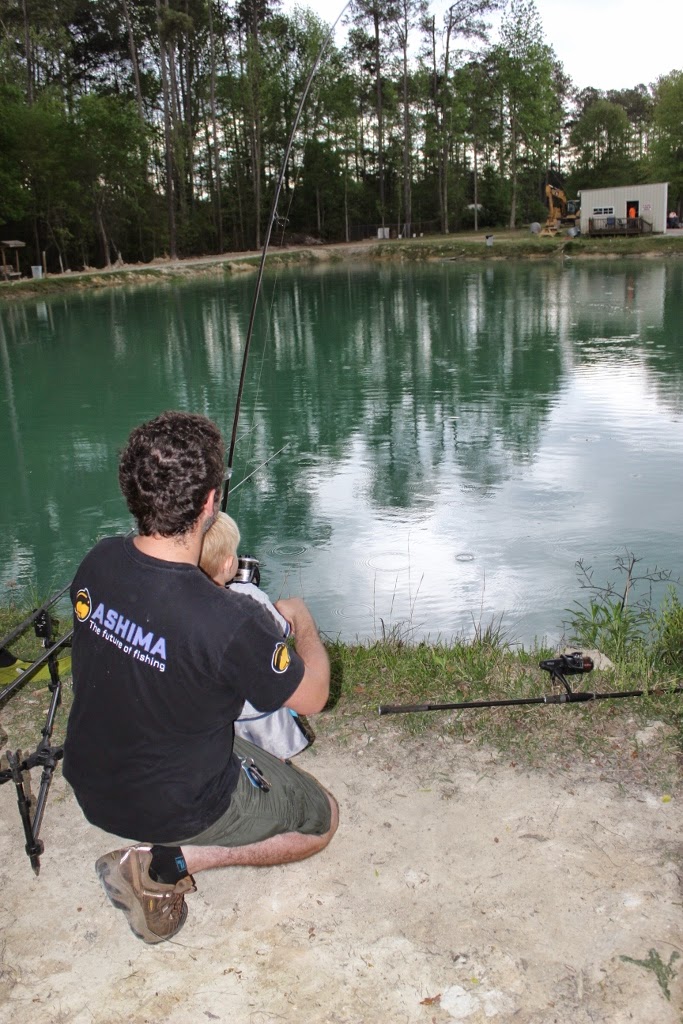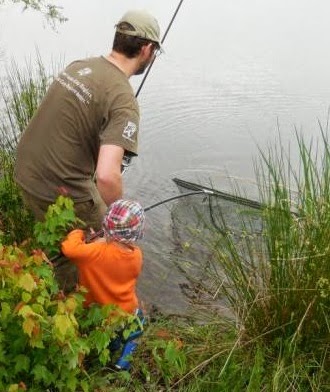Fishing with kids. Much has been written on this topic; some useful and some not so much. Most of these works have been on fishing in general, that is, how to get kids to have a good time fishing. The idea is generally as follows: get the kid(s) to catch fish with as few frustrations as possible. This is indeed sound advice, but I don’t know that it is the whole story as “fishing” to me at least, involves all aspects of aquatic ecology. Since I am addicted to fishing, with a particular fondness for carp, I want my children to enjoy fishing. The following is what I have found so far.
I have read that some people advocate starting your (or someone else’s) youngster fishing at 5 or some such ridiculously old age – don’t listen to them! Luckily this is not at the top of search results – at least the one I did for “kids fishing age”. I say you can take your kids fishing from a few weeks old by investing in a baby carrying device of some sort. This allows you to keep your child with you and allows them to see what you are doing/sleep which is really important for everyone. Just keep a few things in mind: don’t get in a boat and don’t get in waders with a baby strapped to you. I also found that in this way I was also able to get more fishing time as it was a much easier sell to the missus if I was taking care of my parental responsibility at the same time as fishing.
For general fishing (not with a strong carp focus) here is a PDF from takemefishing.org if you are looking for some ideas on taking kids into the wonderful world of fishing. If you want more on carp fishing with kids read on and I will go into detail on my findings.
So, how about carp fishing then? Well basically the normal idea of carp fishing is about as foreign to the idea of taking kids fishing as you can get. One involves doing nothing for long periods of time and the other requires at least some interesting things going at least some of the time. Now the key is to define “interesting”. For very small kids (pre-walking) keeping things interesting is different from those that can walk and so on. Each stage in a child’s development is different and requires different approaches. Often sessions of a few hours are about all that can be handled so manage your time wisely. If fishing for 3hrs does not seem like its worth it then think about what is. For example I have found that while a full session is not an option there is plenty of time to explore new swims, do some feature finding, and even spod a kilo or two of bait.
At this point you may be wondering “did this fool really take his baby carp fishing?” and yes I did and what’s more we had a good time. I will go through the steps that I have taken to get out on the bank when the missus need some well earned rest or it was time for “fishing lessons”. Take what you can use from what I have to say. Every kid is different and what worked or did not work for me will likely be different for you.

First off a checklist of items you might want to take with you. There are a few more things you may need on the bank when you add a child. Some people like to bring loads of kit to the bank with them but this was not my style as I liked a mobile approach to my angling. If you have a barrow load of kit the basic principals should still apply. I found that by simply loosening the straps on my pack I was able to fit most of what I needed in.
|
|
|
Basic items:
- Diapers and wipes (there is nothing that will shorten a fishing trip like a blow out and no way deal with it); after they are out of diapers just the wipes
- Plastic bags or wet bag for said diapers and wipes
- Drinks (water in a camelback sippy bottle is great)
- Snacks (yogurt drops I found to be excellent)
- Sunscreen/bug repellent (kid safe – you may not need these all the time)
- Dry cloths (make sure if fishing during the cooler months they are warm enough)
- Towel (it can be small)
- Hat
Once you have amassed these items you have to remember to bring them so keep a set with you rods or with your bait or in the car – make them hard to forget. These items will take care of a child that is still small enough to be contained most of the time. For larger less containable kids the following are good depending on your location.
Advanced items (in addition to kids fishing stuff):
- Small net for catching frogs, small fish, bugs, etc
- Shovel
- Bucket (for putting things in, such as small fish)
- Books/toys (ones that won’t mind getting muddy/wet)
- Life-vest (PFD) if there is deep water close to the bank
- Their own bait to throw in if you do not want them tossing yours in
Its simple enough to acquire these things and they can help to extend your fishing time for a lot longer.
The next thing is location. You want a spot with a shallow slope into the water so that there is less chance that deeper water can be reach by a small person who has not got the concept of self preservation quite figured out yet. I also like a place that is hard to wander away from, such as a steep bank farther back or a wide open area that has a good line of sight in all directions. These features help you keep an eye on things and make fishing easier. This is not always the case with the swim you might want to fish most but in the next section I will talk about expectations – maybe the biggest part of carp fishing with children.
I have also found that gravel is the best type of ground to be fishing on. This is because it affords an supply of fun and keeps the mud down. While mud is something that is going to happen and is not that big of a deal, I prefer if it is kept to a minimum as I am adverse to cleaning if it can be avoided. Sand is okay and can be better as you move into older children but for some small ones sand is boring…unless you did a big hole and fill it with water for a private mud bath in which case its great.
Another consideration is, of course, what is in the water. While carp are good, they are best if they are in good numbers and if they are not then some other species ideally will fill in the dull periods. In the USA sunfish often fit the bill, but other species can work as well. Amphibians are particularly good, with tadpoles being about as good an entertainer as any you could hope to find. Crayfish are also good and can provide much entertainment. This is where that net and bucket come in and really earn their keep.
.jpg)
Okay, so now expectations. I will keep these ideas short:
- Don’t plan to fish as “hard” as normal
- Don’t plan to fish in the “best” swim (this may have changed)
- Don’t plan to fish as long
- Plan to play some
- Plan to untangle lines
This may seem like the very purpose of life has been taken away from you but I assure you that you can still catch some nice fish with a little planning and there is nothing as good as seeing a small child grow and get excited about catching fish. As I mentioned earlier the more fish there are the better but don’t overlook netting some crayfish to keep things interesting. This also has an added benefit that might not be apparent at the first pass: by catching small organisms for your child to play with you are also figuring out what the carp might be feeding on. I have learned a lot from flipping over some rocks and seeing what I can find. Also keep in mind that time spent on the water is time well spent as you will be able to get a better idea of where the fish are for a later trip even if this time you are not fishing as hard as you would like. As I said above, if fishing for the short amount of time seems pointless then use it for pre baiting, or other fishing related, but less time intensive, activities.
Okay, so that should give you a few ideas to get started with. I will talk later about more specifics of the fishing end of things in a later article. Good luck!




